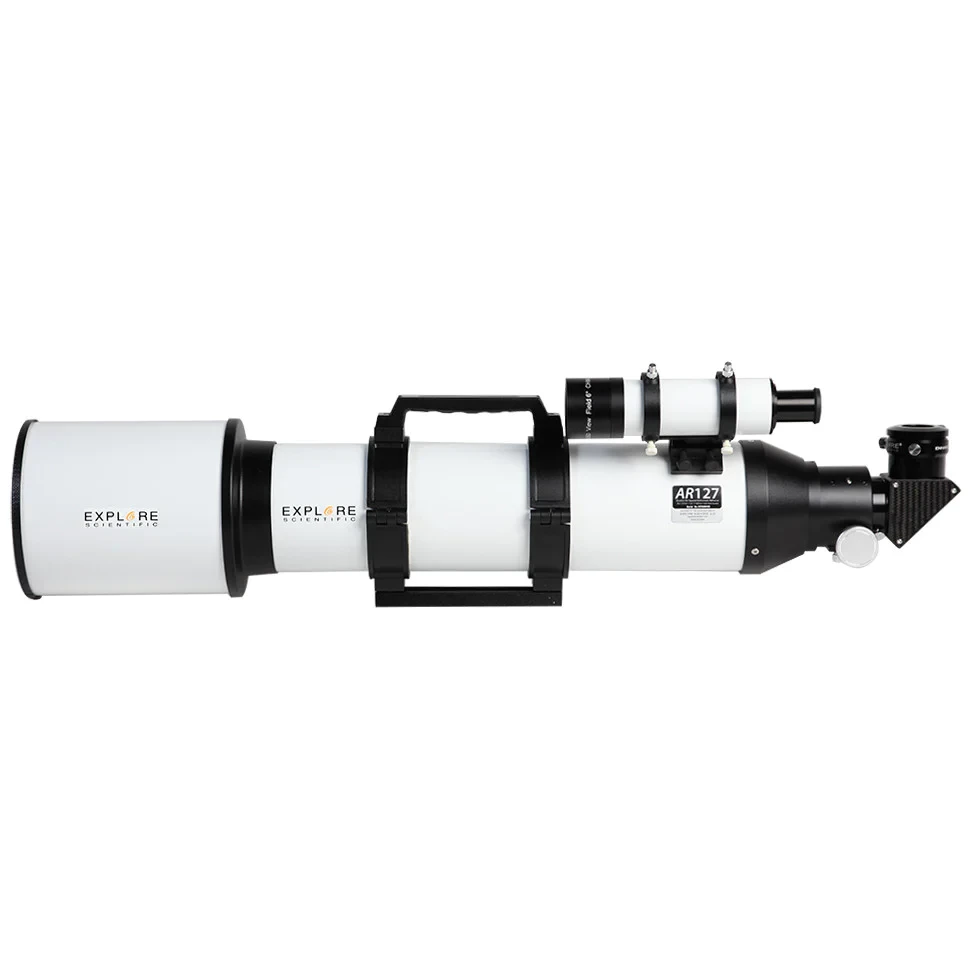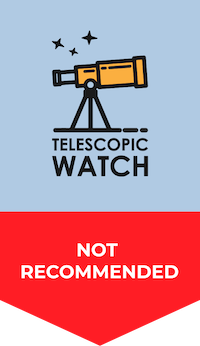Overview
The AR127 is a 5” (127mm) achromatic doublet refractor, possessing an f/6.5 focal ratio and a consequent focal length of 826mm. It incorporates a Fraunhofer doublet objective, which is multi-coated and housed in a collimatable lens cell. While it’s unlikely that adjustments will be necessary, if the need does arise, our collimation guide provides detailed instructions on how to proceed with aligning your AR127 or another refractor.

As is characteristic of all achromatic refractors, the AR127, especially given its large aperture and fast f/6.5 focal ratio, is prone to chromatic aberration. This optical defect, caused by the inability of all wavelengths of light to focus at the same point, manifests as a violet halo around brighter objects and a minor loss of contrast due to unfocused wavelengths of light. For those unfamiliar with achromatic refractors, or for whom chromatic aberration is an annoyance, the AR127 may not be the best choice. Chromatic aberration becomes quite noticeable on objects of 2nd magnitude and brighter, which unfortunately encompasses all major planets, the Moon, and numerous bright stars. That being said, the use of specialized “minus-violet,” “contrast booster,” or “fringe killer” filters can somewhat alleviate the purple halos around these objects, although this comes at the cost of less natural-colored views. A more cost-effective solution would be a simple yellow filter, which can perform satisfactorily in most cases.
The AR127 comes equipped with a relatively robust dual-speed 2″ Crayford focuser. If the provided focuser doesn’t meet your specific needs, replacing it with an aftermarket unit such as those from Moonlite, Feathertouch, or equivalent brands is not a significant challenge. In addition to the one affixed to the AR127’s tube rings, another carry handle is attached just ahead of the focuser on the bottom of the scope’s rear cell.
Additionally, the AR127 includes Explore Scientific’s standard hybrid finder shoe, which secures your finderscope with two nylon thumbscrews. This component accommodates either the provided Explore Scientific-style 50mm finder bracket or the more commonly used Synta/Vixen size.
Accessories
The Explore Scientific AR127 comes packaged with a 2” dielectric mirror diagonal that offers an impressive 99% reflectivity and a durable multi-layer coating that can be cleaned with ordinary lens wipes. This diagonal, fashioned in a robust carbon fiber body, also includes a compression ring adapter. An additional component, a 1.25” compression ring adapter threaded for 2” filters, is also part of the AR127’s provided kit.
To aid you in celestial navigation, the AR127 is equipped with an 8×50 straight-through finderscope, an entry-level but functional accessory. This finderscope produces an inverted up-down image while also featuring crosshairs to pinpoint your celestial targets accurately. If you prefer, you can upgrade to a higher-quality 50mm right-angle correct-image finder. Alternatively, you could augment your finderscope with a reflex sight like the Telrad or Rigel QuikFinder if you prefer the design of these finders.
The AR127 also comes with a handy carry handle attached to the tube rings. The tube rings are integrated with a standard Vixen-style dovetail at the base, which ensures ease of attachment to most commonly used astronomical mounts.
Previously, the AR127 was accompanied by a robust carrying case, an aspect many found quite useful. However, it’s worth noting that Explore Scientific has discontinued this offering, and the telescope now arrives without it. The AR127 will not fit the case designed for the more expensive ED127 Essentials refractor.
Mounting Recommendations
Being a hefty refractor, the AR127 demands a strong, sturdy mount and tripod. Unfortunately, specific mounting recommendations aren’t provided by Explore Scientific, leaving users to research and decide independently. This occasionally results in the choice of less robust and occasionally inadequate mounts. For visual usage, a German equatorial mount of the EQ-5 class should be sufficient. There are numerous excellent choices available, including the Celestron Advanced VX, Orion Sirius EQ-G, Meade LX85, Sky-Watcher HEQ5, iOptron CEM25p, and Losmandy GM-8. Explore Scientific’s own EXOS-2GT is also a viable option.
The AR127 also works well on a suitably robust alt-azimuth mount, such as the Losmandy AZ8 or Sky-Watcher AZ-EQ5. We would not recommend the lightweight Twilight I or Vixen Porta II mounts for the AR127; while usable, they are simply too unsteady due to the weight and length of this scope.
Should I buy a Used Explore Scientific AR127?
If you come across a used AR127 for sale, whether online or in person, it’s relatively straightforward to check for visible damage to the objective lens or the tube. The AR127 design has seen few changes in its roughly 15 years on the market, though older units might not feature a Synta-compatible dual finder shoe. However, they may come with a sturdy aluminum hard case, which is a valuable addition if you can acquire one.
Alternative Recommendations
The AR127 doesn’t have a lot of peer equivalents – the 120mm refractors from Celestron, Sky-Watcher and Orion are the closest comparisons, but these are typically either faster/slower optically and thus more specialized for planetary/deep-sky viewing, respectively. A 110-130mm apochromatic refractor, either an ED doublet or triplet, is likely to be better than the AR127 for general-purpose viewing as well as deep-sky imaging, though these telescopes are typically quite expensive and often fairly heavy, especially good triplets.
We would recommend checking out our telescope rankings and considering one of our Best Dobsonians or Best Schmidt-Cassegrains if this is to be your first telescope; likewise, for astrophotography, check out our imaging OTA rankings and mounts. An 8” Dobsonian such as those offered by Apertura, Orion, or Celestron will easily beat the AR127 in terms of clarity and image brightness at the eyepiece, as will a larger 10”. Even a 6” f/5 tabletop Dobsonian like the Sky-Watcher Heritage 150P will tend to be comparable to the AR127 in all types of viewing.
Aftermarket Accessory Recommendations
Should your primary aim be to use the AR127 for visual observation, and you don’t already have a collection of eyepieces, we recommend investing in a basic set. This set should include a 30-40mm 2” wide-angle eyepiece, a ~24mm wide-angle eyepiece, and eyepieces with focal lengths of approximately 6, 9, and 15mm. Explore Scientific, a reputable leader in the eyepiece industry, offers a wealth of options across various focal lengths, apparent fields of view, and price ranges. A comprehensive starter set for the AR127 could consist of a 40mm ES68, a 24mm ES82, a 14mm ES82, an 8.5mm ES82, and a 6.5mm ES82.
What can you see?
Although a 5″ telescope such as the AR127 may seem somewhat less impressive in terms of its light gathering and resolving power when juxtaposed with larger reflectors, it’s crucial not to overlook its capabilities. Owing to its unobstructed design, a 5” refractor can nearly hold its own against an 8” Dobsonian when the task at hand involves observing deep-sky objects. The AR127 can serve as a gateway to dozens of open star clusters, each of them brimming with bright, colorfully radiant stars. With the help of a 2” wide-angle eyepiece, the AR127 proves adept at capturing the vast expanse of larger clusters. Notable examples include the Pleiades (M45), Beehive (M44), and Double Cluster, all of which comfortably fit within the field of view of the AR127. Compact clusters like M35 and M11 don’t disappoint either, providing impressive visuals through the eyepiece of the telescope.
Under conditions conducive to using high magnification, the AR127 will allow you to split a considerable number of double stars. Most of these will appear as perfect, sharp pinpoints of light, adding to the observing experience. Moreover, a 5” refractor has the power to resolve individual stars in some of the brightest and largest globular clusters, with M13 and M3 being prime examples – though fainter globulars will remain elusive fuzzy balls with no sign of individual stellar members.
When you aim the AR127 at larger nebulae, it doesn’t disappoint either. Significant planetary nebulae such as the Dumbbell and Helix, the expansive Veil Nebula supernova remnant, the smaller Crab Nebula, and luminous emission nebulae like Orion (M42), the Lagoon (M8), and the Swan (M17) are all within its reach. However, it’s important to note that for optimal viewing of these nebulae, dark skies and a UHC nebula filter are highly recommended. Light-polluted skies can rob these celestial wonders of much of their detail, and observing them unfiltered might result in a less contrasted view. But fear not, as even under the glow of suburban skies, the AR127 can present the brightest targets, like M42 and M8, in an impressive manner. And under darker conditions, these views become nothing short of spectacular.
Galaxies are a little lackluster with a telescope as small as the AR127. M82, M31, M104, and a few other galaxies may show dust lanes, and clusters like the many brighter members of the Virgo Cluster are visible – but don’t expect much detail; spiral arms require dark skies and a larger telescope to clearly resolve in most galaxies, while even the brightest galaxies are relatively faint with only a 5” aperture – especially under light-polluted skies.
When used for planetary viewing, the AR127 presents certain constraints inherent to its design – namely its modest aperture and the fairly high amount of chromatic aberration present. However, chromatic aberration is controlled well enough that you can still get decent high-power views, although nowhere near as sharp as those of a similar aperture reflector, catadioptric, or apochromatic refractor.
Venus’ phases are clearly visible through the AR127, although observers should be prepared for a significant violet halo encircling the planet. On the other hand, observing Mercury’s phases can be more challenging due to its smaller size and the difficulty of spotting it while it’s still high in the sky. The Moon, in stark contrast, provides a rewarding experience, offering an array of sharp, high-resolution details for the viewer’s delight.
For achromatic refractors such as the AR127, observing Mars can prove to be a significant hurdle. The planet’s distinctive red color tends to amplify the effects of chromatic aberration. Under optimal viewing conditions, one might be able to distinguish an ice cap or a few dark markings on Mars, but these features would generally be elusive. However, when observing Jupiter, its various cloud belts, the renowned Great Red Spot, and other atmospheric phenomena are discernible. Furthermore, the four Galilean moons of Jupiter can be identified as tiny specks, occasionally casting shadows as they transit across the planet’s surface.
The AR127 proves its mettle when observing Saturn, revealing not only the planet’s iconic rings but also the Cassini Division within them. In addition, some of Saturn’s moons and its muted brown-tan cloud bands are visible. Turning to the outer planets, the disk of Uranus can be vaguely resolved, whereas Neptune’s disk may be harder to differentiate from a star. However, this telescope’s light-gathering capability falls short of revealing Pluto or the moons of Uranus, and Neptune’s moon Triton is difficult to spot, if you can even see it at all.
Astrophotography
The AR127, like other fast achromatic refractors, exhibits a substantial amount of chromatic aberration, which tends to be more conspicuous in astrophotography than in direct viewing. For those serious about lunar and planetary photography, the AR127 is a rather poor choice. More cost-effective alternatives, such as a 6” Schmidt-Cassegrain or Maksutov, will provide superior results, bypassing the need to stack Barlow lenses to reach the necessary focal length, which can degrade image quality. With the AR127, one can achieve usable deep-sky results using a DSLR and a cooled camera, but this requires a substantial mount with good autoguiding. Employing heavy filtering or narrowband imaging can somewhat mitigate the effects of chromatic aberration, but it’s essential to manage expectations when attempting deep-sky astrophotography with an achromat. For those particularly interested in astrophotography, it’s worth considering smaller apochromatic refractors. These instruments, available at a price range similar to the AR127, generally outperform it in this domain.


